

Changes of brain gray matter structure in Parkinson's disease patients with dementia. Protein mystery of three brain diseases unraveled. The accumulation of one particular protein in the brain is at the basis of three very different age-related conditions.

Until recently, nobody understood how this was possible. Research by the Laboratory for Neurobiology and Gene Therapy (KU Leuven) now reveals that the shape of the protein determines the clinical picture. The presence of α-synuclein protein deposits in the brain is characteristic for three different diseases: Parkinson's disease (PD), multiple system atrophy (MSA) and dementia with Lewy bodies (DLB). Current Perspective of Mitochondrial Biology in Parkinson’s Disease. Parkinson's: A Syndrome Rather Than a Disease? - PubMed. Emerging concepts suggest that a multitude of pathology ranging from misfolding of alpha-synuclein to neuroinflammation, mitochondrial dysfunction, and neurotransmitter driven alteration of brain neuronal networks lead to a syndrome that is commonly known as Parkinson's disease.
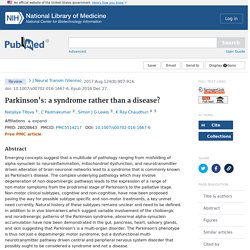
The complex underlying pathology which may involve degeneration of non-dopaminergic pathways leads to the expression of a range of non-motor symptoms from the prodromal stage of Parkinson's to the palliative stage. Non-motor clinical subtypes, cognitive and non-cognitive, have now been proposed paving the way for possible subtype specific and non-motor treatments, a key unmet need currently. Natural history of these subtypes remains unclear and need to be defined. Keywords: Individualized medicine; Neurotransmitter; Non-motor subtypes; Non-motor symptoms; Parkinson’s disease; Parkinson’s syndrome.
Current Perspective of Mitochondrial Biology in Parkinson’s Disease. Genetic risk of Parkinson disease and progression: Are dementia with Lewy bodies and Parkinson’s disease dementia the same disease? Neuroimaging in pre-motor Parkinson's disease. Neuroimaging of Parkinson’s Disease: Expanding views. Imaging of Motor Cortex Physiology in Parkinson's Disease. Advances in Parkinson’s Disease: 200 Years Later. Editor's Choice: Uncovering the role of the insula in non-motor symptoms of Parkinson’s disease. Protein mystery of three brain diseases unraveled. Researchers find brain cell that triggers tremor and how to control it. Researchers at Baylor College of Medicine and the Jan and Dan Duncan Neurological Research Institute at Texas Children's Hospital have improved our understanding of how tremor -- the most common movement disorder -- happens, opening the possibility of novel therapies for this condition.

Working with animal models, the researchers discovered that a particular brain cell type, known as the Purkinje cell, triggers tremor when its pattern of signaling to other neurons changes from a regular pattern to signaling in bursts. The altered signaling pattern returned to normal and the tremor stopped when the animals were treated with deep-brain stimulation directed at a group of cerebellar neurons that communicate with Purkinje cells. The study appears in the journal eLife. "Tremor is an involuntary, rhythmic shaking movement in one or more parts of the body. Being right-brained or left-brained comes down to molecular switches: Findings may explain why Parkinson's disease and other neurological disorders impact one side of the body before the other.
Scientists may have solved one of the most puzzling and persistent mysteries in neuroscience: why some people are "right-brained" while others are "left-brained.

" The answer lies in how certain genes on each side of the brain are switched "on" and "off" through a process called epigenetic regulation. The findings may explain why Parkinson's disease and other neurological disorders frequently affect one side of the body first, a revelation that has far-reaching implications for development of potential future treatments.
The study was led by Van Andel Institute's Viviane Labrie, Ph.D., and published in the journal Genome Biology. Parkinson's disease may start in the gut. Researchers at Karolinska Institutet in Sweden and the University of North Carolina in the USA have mapped out the cell types behind various brain disorders.
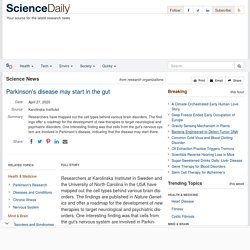
The findings are published in Nature Genetics and offer a roadmap for the development of new therapies to target neurological and psychiatric disorders. One interesting finding was that cells from the gut's nervous system are involved in Parkinson's disease, indicating that the disease may start there. The nervous system is composed of hundreds of different cell types with very different functions. It is vital to understand which cell types are affected in each disorder so as to understand the causes of the disorders and, ultimately, develop new treatments. "As expected, we found that dopaminergic neurons were associated with Parkinson's disease. Parkinson's dyskinesia mechanism explained. Many people with Parkinson's disease eventually develop debilitating movements called dyskinesia, a side effect of their much-needed dopamine replacement medication.
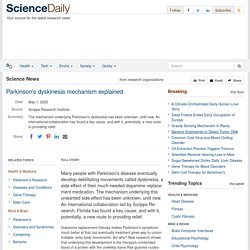
The mechanism underlying this unwanted side effect has been unknown, until now. An international collaboration led by Scripps Research, Florida has found a key cause, and with it, potentially, a new route to providing relief. Dopamine replacement therapy makes Parkinson's symptoms much better at first, but eventually treatment gives way to uncontrollable, jerky body movements. Novel treatment using patient's own cells opens new possibilities to treat Parkinson's disease.
Reprogramming a patient's own skin cells to replace cells in the brain that are progressively lost during Parkinson's disease (PD) has been shown to be technically feasible, reports a team of investigators from McLean Hospital and Massachusetts General Hospital (MGH) in the most recent issue of the New England Journal of Medicine.

PD is the second most common degenerative disease of the brain, and millions of people world-wide experience its symptoms, which include tremor, stiffness, and difficulty with speech and walking. The progressive loss of brain cells called dopaminergic neurons plays a major role in the disease's development. As described in the current report, the use of a patient's own reprogrammed cells is an advance that overcomes barriers associated with the use of cells from another individual. Scientists find evidence of link between diesel exhaust, risk of Parkinson's. A new UCLA study in zebrafish identified the process by which air pollution can damage brain cells, potentially contributing to Parkinson's disease.

Published in the peer-reviewed journal Toxicological Sciences, the findings show that chemicals in diesel exhaust can trigger the toxic buildup of a protein in the brain called alpha-synuclein, which is commonly seen in people with the disease. Previous studies have revealed that people living in areas with heightened levels of traffic-related air pollution tend to have higher rates of Parkinson's. To understand what the pollutants do to the brain, Dr. Jeff Bronstein, a professor of neurology and director of the UCLA Movement Disorders Program, tested the effect of diesel exhaust on zebrafish in the lab. "It's really important to be able to demonstrate whether air pollution is actually the thing that's causing the effect or whether it's something else in urban environments," Bronstein said.
Can gut infection trigger Parkinson's disease? A new study by Montreal scientists published today in Nature demonstrates that a gut infection can lead to a pathology resembling Parkinson's disease (PD) in a mouse model lacking a gene linked to the human disease.
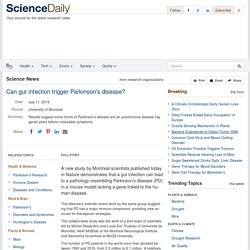
This discovery extends recent work by the same group suggesting that PD has a major immune component, providing new avenues for therapeutic strategies. The collaborative study was the work of a joint team of scientists led by Michel Desjardins and Louis-Eric Trudeau of Université de Montréal, Heidi McBride at the Montreal Neurological Institute, and Samantha Gruenheid at McGill University.
The number of PD patients in the world more than doubled between 1990 and 2016, from 2.5 million to 6.1 million. Parkinson's disease may start before birth: Stem cell study finds malfunctioning brain cells in patients who were diagnosed before age 50; researchers test potential new treatment. People who develop Parkinson's disease before age 50 may have been born with disordered brain cells that went undetected for decades, according to new Cedars-Sinai research.
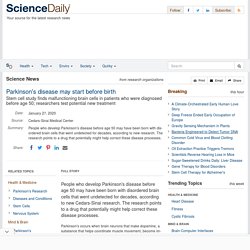
The research points to a drug that potentially might help correct these disease processes. Parkinson's occurs when brain neurons that make dopamine, a substance that helps coordinate muscle movement, become impaired or die. Symptoms, which get worse over time, include slowness of movement, rigid muscles, tremors and loss of balance. In most cases, the exact cause of neuron failure is unclear, and there is no known cure. At least 500,000 people in the U.S. are diagnosed with Parkinson's each year, and the incidence is rising. Parkinson's Disease. Causes of Parkinson's Disease After a Parkinson's diagnosis, people often ask "Why? " For most people, the cause of Parkinson's is unknown ("idiopathic"). Researchers believe that Parkinson's is caused by a combination of factors.
If a continuum existed, with genetic causes at one end and environmental causes at the other, people with Parkinson's would fall at many different places. Some cases may be due more to genetics, and others more influenced by environmental factors. Association of Subthalamic Deep Brain Stimulation With Motor, Functional, and Pharmacologic Outcomes in Patients With Monogenic Parkinson Disease.
Monoamine Reuptake Inhibitors in Parkinson's Disease. SMPD1 mutations, activity and α-synuclein accumulation in Parkinson’s disease. A Proposed Roadmap for Parkinson’s Disease Proof of Concept Clinical Trials Investigating Compounds Targeting Alpha-Synuclein. Dementia and Parkinson's Disease: Similar and Divergent Challenges in Providing Palliative Care. Imaging Markers of Progression in Parkinson's Disease.
The Significance of α-Synuclein, Amyloid-β and Tau Pathologies in Parkinson’s Disease Progression and Related Dementia. Basal ganglia dysfunction in idiopathic REM sleep behaviour disorder parallels that in early Parkinson’s disease. Imaging insights into basal ganglia function, Parkinson’s disease, and dystonia. The psychosis spectrum in Parkinson disease. Past, Present, and Future of Parkinson’s Disease: A Special Essay on the 200th Anniversary of the Shaking Palsy. Visual dysfunction in Parkinson’s disease. A Systematic Review of the Literature on Disorders of Sleep and Wakefulness in Parkinson’s Disease From 2005-2015.
Cognitive decline in Parkinson disease. Neurobehavioral Mechanisms of Temporal Processing Deficits in Parkinson's Disease. Parkinson’s: a syndrome rather than a disease? Probiotics for Parkinson’s Disease. Imaging in Parkinson’s disease. Parkinson's Disease and Parkinsonism - PubMed. Cognition in Parkinson's Disease - PubMed. Cognitive decline is now recognized as a common nonmotor symptom of Parkinson's disease, and it has been the subject of increasing research in recent decades. Cognitive deficits in Parkinson's disease can be distinguished as dopaminergically mediated executive dysfunction seen in the milder stages vs a global dementia syndrome that can occur with disease progression. The neural basis of these deficits has been explored from the perspective of multimodal imaging techniques to measure the structural, functional, and metabolic correlates of cognitive decline in Parkinson's disease.
Increasingly, changes in neurotransmitter systems beyond dopamine, including the noradrenergic, serotonergic, and cholinergic systems, are being recognized for their contribution to cognitive decline. Exercise for Parkinson's Disease - PubMed. Parkinson's disease is the second most common neurodegenerative disease with a prevalence rate of 1-2 per 1000 of the population worldwide. Pharmacological management is the mainstay of treatment. Despite optimal medication, motor impairment particularly balance and gait impairment persist leading to various degree of disability and reduced quality-of-life.
The present review describes motor impairment including postural impairment, gait dysfunction, reduced muscle strength and aerobic capacity and falls. Physical therapy and complementary exercises have been proven to improve motor performance and functional mobility. Non-motor Symptoms in Parkinson's Disease - PubMed. Parkinson's disease: A review Radhakrishnan DM, Goyal V Neurol India. Parkinson's disease: A review Divya M Radhakrishnan, Vinay Goyal Department of Neurology, All India Institute of Medical Sciences, New Delhi, India Correspondence Address:Dr. Biomarkers for Parkinson’s Disease: Recent Advancement. Diagnosis and Management of Parkinson's Disease - PubMed.
Despite numerous efforts to identify specific and sensitive biomarkers, the diagnosis of Parkinson's disease (PD) is still based on clinical criteria that include the presence of a combination of cardinal motor features (tremor, rigidity, bradykinesia, and postural instability), other motor features (including freezing of gait and abnormal postures), and numerous nonmotor features. In addition, the presence of atypical features may suggest an alternative diagnosis. Levodopa therapy remains the gold standard in the management of motor features of PD. Parkinson’s Disease. Biomarkers for Parkinson’s Disease: Recent Advancement. Parkinson's disease. Motor assessment in Parkinson`s disease.
The clinical symptoms of Parkinson's disease - Sveinbjornsdottir - 2016 - Journal of Neurochemistry. Epidemiology of Parkinson's Disease - PubMed. Parkinson's Disease Psychosis: Presentation, Diagnosis and Management - PubMed. Parkinson's disease - The Lancet. Clinical Motor and Cognitive Neurobehavioral Relationships in the Basal Ganglia. Parkinson’s and Alzheimer’s Diseases: Similar But Very Different. James Parkinson Biography.